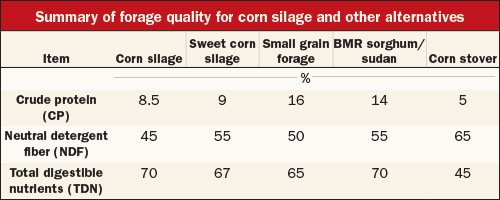This year's harvest marks two very different ends of the spectrum. Some dairies have been blessed with an abundance of forage to feed over the coming year. Meanwhile, others, due to late or prevented planting, have a reduction in forage for the upcoming year.
If your dairy falls into the latter category, it is critical to develop an accurate representation of your current forage inventory. The next step, notes Jim Paulson, extension dairy educator with the University of Minnesota, is to build a feed and forage budget for your farm.
Quickly calculating what you have and what you lack enables you to identify and secure alternative feed sources. Of the forages you have on hand, the highest quality material should be allocated to the milking herd and youngest heifers.
Paulson then highlighted three alternative forage options to fill in feed inventory gaps.

The author, Amanda Smith, was an associate editor and an animal science graduate of Cornell University. Smith covers feeding, milk quality and heads up the World Dairy Expo Supplement. She grew up on a Medina, N.Y., dairy, and interned at a 1,700-cow western New York dairy, a large New York calf and heifer farm, and studied in New Zealand for one semester.
If your dairy falls into the latter category, it is critical to develop an accurate representation of your current forage inventory. The next step, notes Jim Paulson, extension dairy educator with the University of Minnesota, is to build a feed and forage budget for your farm.
Quickly calculating what you have and what you lack enables you to identify and secure alternative feed sources. Of the forages you have on hand, the highest quality material should be allocated to the milking herd and youngest heifers.
Paulson then highlighted three alternative forage options to fill in feed inventory gaps.
- Late planted corn: With the reduction in corn grain prices, some farms may find the opportunity to purchase late planted corn to add to their corn silage supply. In some areas, there is a good chance that corn may not mature before a killing frost making this option particularly appealing to crop producers looking to reduce their risk.
If a producer plans to purchase a field of standing corn, the crop must be priced before harvest. One option is to price the forage based on a post-harvest forage test and the known quantity of forage harvested. For the ease of calculating silage needs, Paulson recommends estimating wet silage tons (using 65 percent moisture) and adjusting from there. It is also best to put a minimum price floor if using a postharvest test to cover the value of fertility and organic matter.
Furthermore, Paulson added, consideration must be given to harvest cost. Typically, harvest costs average $100 per acre, depending on whether the crop will be used for silage or grain. The value of the corn grain per ton of silage is approximately seven to eight bushels of corn per wet ton of silage.
- Sweet corn silage: Sweet corn silage, or cannery waste, can be a low-cost alternative in certain areas. Sweet corn silage compares favorably to regular corn silage, noted Paulson, but it will be lower in starch. With any alternative forage, acquiring digestibility rates and neutral detergent fiber estimates is a good investment. There is the potential to overestimate the energy content of the forage if the NDF digests slower than predicted.

- Other alternatives: Alternative forages could include cover crops that became available for harvest after November 1. While these can be risky to rely on, added Paulson, the forage value as either harvested or grazed forage can be relatively high. The crops will usually be priced on how they compare to alfalfa haylage and small grain silages. A wet chemistry forage test will need to be done to obtain an accurate forage analysis.

The author, Amanda Smith, was an associate editor and an animal science graduate of Cornell University. Smith covers feeding, milk quality and heads up the World Dairy Expo Supplement. She grew up on a Medina, N.Y., dairy, and interned at a 1,700-cow western New York dairy, a large New York calf and heifer farm, and studied in New Zealand for one semester.








